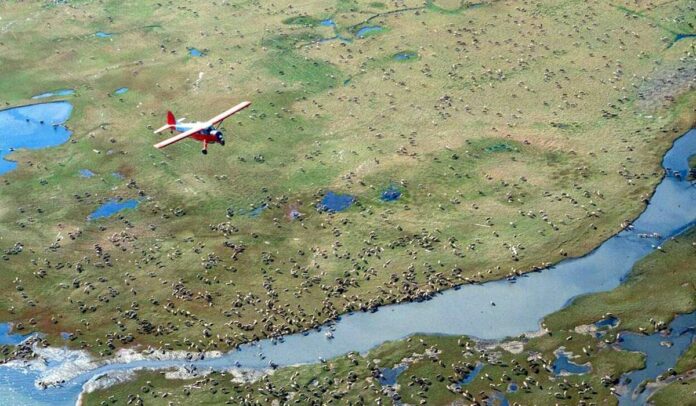The Interior Department finalized Monday a leasing program in the Arctic National Wildlife Refuge, moving to unlock a potential oil-and-gas gusher in the Alaska wilderness and underscoring the Trump administration’s energy-independence push.
Interior Secretary David Bernhardt said that the first lease could be approved before the end of the year after signing a Record of Decision to approve the Coastal Plain Oil and Gas Leasing Program, which governs drilling on the 1.56 million-acre section, or about 8% of the 19.3 million-acre refuge.
“I have signed and we have issued our decision for how the required oil-and-gas program will be accomplished in a manner that responsibly develops this national energy resource and uses the best available science to mitigate the impact to the surrounding landscape and wildlife,” said Mr. Bernhardt on a press call.
He emphasized that exploration of the coastal plain is not optional: After a 40-year debate, Congress directed Interior to hold at least two lease sales, the first by December 2021, in the Tax Cuts and Jobs Act of 2017, which opened up the refuge for development.
“The new law settled the question of whether the leasing exploration and development and transportation of natural gas could occur on small portion of ANWR,” Mr. Bernhardt said. “The law makes oil and gas development one of the purposes of the refuge, clearly directing me acting through the Bureau of Land Management to carry out a competitive exploration and development program for the potentially energy-rich coastal plain.”
Even so, Democrats and environmental advocates who have long opposed drilling in ANWR decried the leasing program’s approval, citing the risk to wildlife and the potential worsening of the “climate crisis.”
Gina McCarthy, who headed the Environmental Protection Agency under President Barack Obama, said the Trump administration’s “reckless, relentless boosting of the oil industry will irrevocably damage this cherished place and compound the global climate crisis. We will not let it stand.”
“The Trump administration never stops pushing to drill in the Arctic Refuge — and we will never stop suing them,” said Ms. McCarthy, now president of the Natural Resources Defense Council.
Rep. Diana DeGette, Colorado Democrat, tweeted, “If we don’t act fast, this will be a devastating blow to our entire ecosystem – and it must be stopped!
Meanwhile, Republicans hailed the development of oil reserves in what is known as the 1002 Area estimated at between 4.3 and 11.8 billion barrels, which is expected to pour billions into Alaska’s oil-reliant economy after the withdrawal in recent years of several drilling companies.
Alaska Gov. Michael J. Dunleavy called the signing “a milestone in Alaska’s 40-year journey to responsibly develop our State and our Nation’s new energy frontier,” while Rep. Don Young, Alaska Republican, called it a “great day, not only for the State of Alaska, but also for American energy independence.”
“I thank all Alaskans who have worked for more than 40 years for responsible resource development in the 1002 area of ANWR,” said Sen. Dan Sullivan, Alaska Republican. “I particularly applaud the tireless advocacy of the many Alaska Natives — who call the area home — and who know firsthand how responsible oil production can provide enormous economic and social benefits while having minimal impact on the environment.”
Today BLM released its Record of Decision for an oil and gas program in the non-wilderness Coastal Plain of ANWR. Through this program, we will build on our already-strong record of an increasingly minimal footprint for responsible resource development.https://t.co/X6UfZxjJEF pic.twitter.com/s4346bFSPU
— Sen. Lisa Murkowski (@lisamurkowski) August 17, 2020
Mr. Bernhardt estimated that development and production would begin about eight years after oil is found and continue for the next 50 years.
Ms. McCarthy noted that the Gwich’in tribes oppose the ANWR development, saying it “threatens the heart of the largest pristine wildland left in America,” while Mr. Bernhardt pointed out that the Inuit people who live on the Northern Slope support it.
The approved plan includes restrictions on surface occupancy and operational timing aimed at protecting habitat and wildlife, including the caribou herds that call the region home.
“All permitted activities will incorporate required operating procedures and stipulated restrictions based on the best science and technology to ensure that energy development does not come at the expense of the environment,” said the Interior Department.






